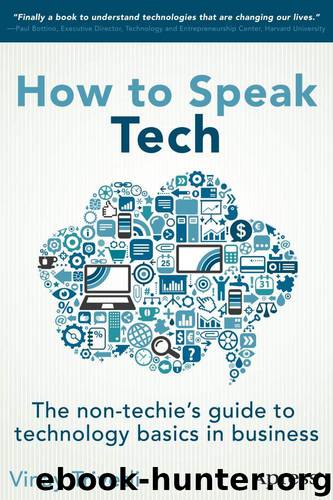How to Speak Tech: The Non-Techie's Guide to Technology Basics in Business by Vinay Trivedi

Author:Vinay Trivedi
Language: eng
Format: mobi, epub
Tags: Business & Management, Business & Investing, Web Marketing, E-Commerce, Computer Science, Business & Finance, Computers & Technology, Industries & Professions
ISBN: 9781430266105
Publisher: Apress
Published: 2013-12-26T05:00:00+00:00
From the accelerating explosion in the number of APIs—from a mere handful in 2005 to more than 10,000 in September 2013—you may safely infer that MyAppoly will need an API to be a player. The success of your API will depend on how easy it is for developers to learn, use, and integrate.
How Do APIs Work?
The technicals underlying APIs can get complicated, but the basics are simple. First, it is important to emphasize that APIs are software-to-software interfaces. Applications talk to each other without your involvement. If MyAppoly needs to show the weather, for example, the software can communicate (“make calls”) with a weather API in the background to obtain the most updated weather report before showing it to the user, as detailed in the following example.
One way you could retrieve the weather would be through the weather website (direct access). Alternatively, you could go through a middleman—an API—that stands in between you and the weather website. Now instead of accessing the weather directly through a browser, the API tells you that you have to submit whatever you want via code. But how do you know what to write? The API provides documentationthat tells you what the valid requests are and how exactly to write them. (The API is picky and only processes your code if you write it in the precise way it understands). So, after reading the API’s instructions and rules, you specify that you want the weather by writing the getWeather function outlined in the API’s documentation. Now when you give the function to the API, it turns around and interacts with the server to retrieve your information. The API then returns the results to you in a format that easily digestible (typically XML or JSON, discussed in the “JavaScript Object Notation” section of this chapter). Depending on what the API allows you to do, you could theoretically get all the information you want through the API and never have to visit the website again through a browser. It’s not all about the data though, so do focus on design and user experience. Plenty of your visitors will expect your actual website to look good even if you do offer an API. APIs that extend functionality in addition to data operate in a similar fashion.
From this example, you can see that APIs are designed for software developers and can be defined as “a set of routines (usually functions) and accompanying protocols for using these functions that provide building blocks for software development.” They allow users to connect to the application via a secure channel and then run functions using code to get information or to borrow functionality.
Two of the more popular types of APIs—Representational State Transfer (REST) and Simple Object Access Protocol (SOAP)—are described and compared in the next sections.
REST
REST is an architectural style developed by Roy Thomas Fielding to allow the Web to be more scalable. To follow REST’s architectural style and be considered RESTful, one must follow a set of conditions that are not presented here but are easily found online.
Download
How to Speak Tech: The Non-Techie's Guide to Technology Basics in Business by Vinay Trivedi.epub
This site does not store any files on its server. We only index and link to content provided by other sites. Please contact the content providers to delete copyright contents if any and email us, we'll remove relevant links or contents immediately.
Bad Blood by John Carreyrou(6517)
Rich Dad Poor Dad by Robert T. Kiyosaki(6354)
Principles: Life and Work by Ray Dalio(6169)
Playing to Win_ How Strategy Really Works by A.G. Lafley & Roger L. Martin(5853)
Management Strategies for the Cloud Revolution: How Cloud Computing Is Transforming Business and Why You Can't Afford to Be Left Behind by Charles Babcock(4508)
The Confidence Code by Katty Kay(4172)
Thinking in Bets by Annie Duke(4139)
American Kingpin by Nick Bilton(3735)
Delivering Happiness by Tony Hsieh(3353)
Project Animal Farm: An Accidental Journey into the Secret World of Farming and the Truth About Our Food by Sonia Faruqi(3163)
The Power of Habit by Charles Duhigg(3043)
Brotopia by Emily Chang(2989)
The Tyranny of Metrics by Jerry Z. Muller(2979)
Mastering Bitcoin: Programming the Open Blockchain by Andreas M. Antonopoulos(2964)
The Marketing Plan Handbook: Develop Big-Picture Marketing Plans for Pennies on the Dollar by Robert W. Bly(2950)
I Live in the Future & Here's How It Works by Nick Bilton(2919)
The Content Trap by Bharat Anand(2850)
Applied Empathy by Michael Ventura(2825)
Building a StoryBrand by Donald Miller(2825)
